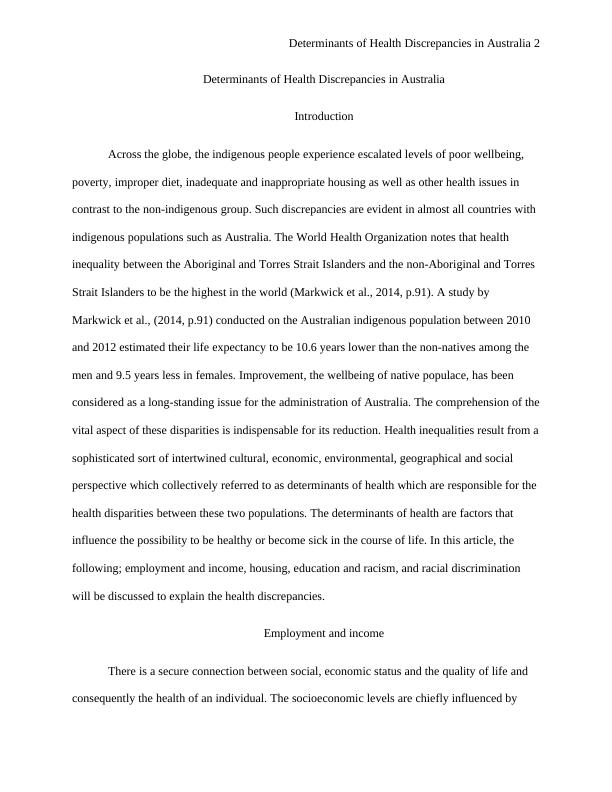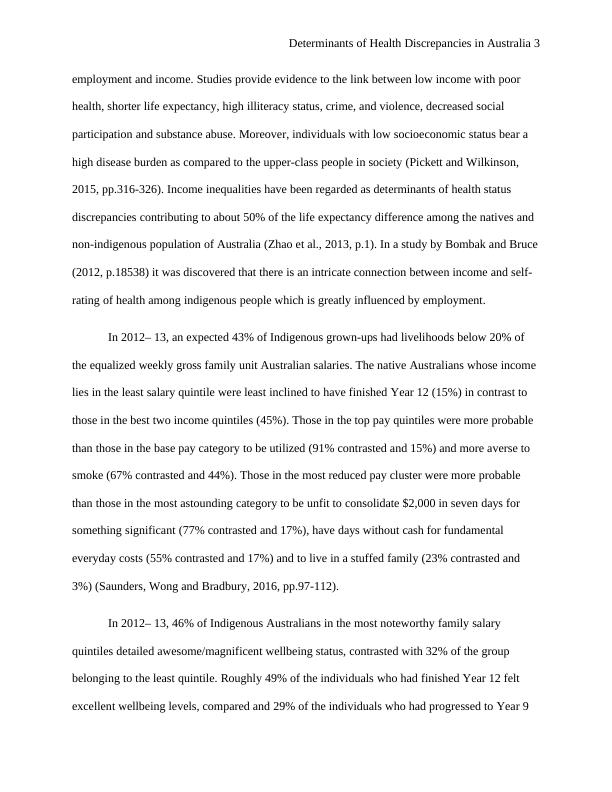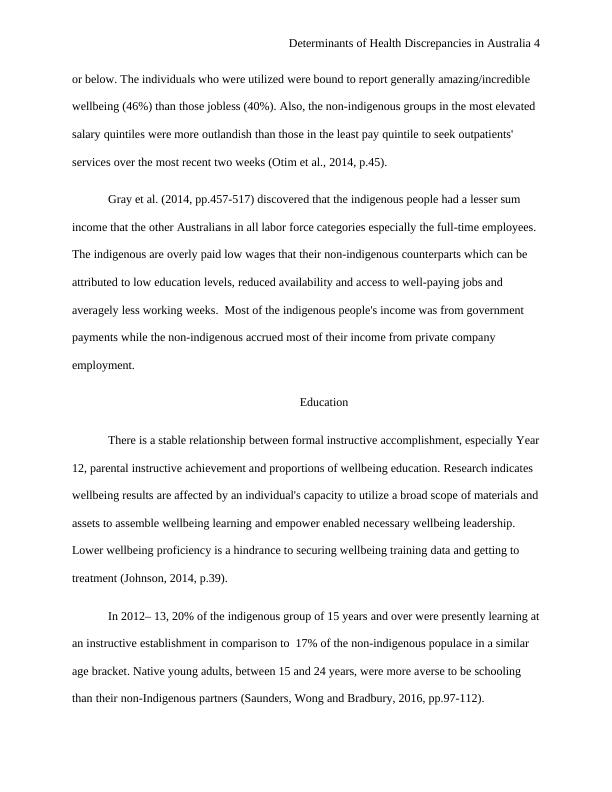Determinants of Health Discrepancies in Australia
Added on 2022-11-29
11 Pages3022 Words456 Views
Determinants of Health Discrepancies in Australia 1
Determinants of Health Discrepancies in Australia
By [Name]
Course
Professor’s Name
Institution
Location of Institution
Date
Determinants of Health Discrepancies in Australia
By [Name]
Course
Professor’s Name
Institution
Location of Institution
Date

Determinants of Health Discrepancies in Australia 2
Determinants of Health Discrepancies in Australia
Introduction
Across the globe, the indigenous people experience escalated levels of poor wellbeing,
poverty, improper diet, inadequate and inappropriate housing as well as other health issues in
contrast to the non-indigenous group. Such discrepancies are evident in almost all countries with
indigenous populations such as Australia. The World Health Organization notes that health
inequality between the Aboriginal and Torres Strait Islanders and the non-Aboriginal and Torres
Strait Islanders to be the highest in the world (Markwick et al., 2014, p.91). A study by
Markwick et al., (2014, p.91) conducted on the Australian indigenous population between 2010
and 2012 estimated their life expectancy to be 10.6 years lower than the non-natives among the
men and 9.5 years less in females. Improvement, the wellbeing of native populace, has been
considered as a long-standing issue for the administration of Australia. The comprehension of the
vital aspect of these disparities is indispensable for its reduction. Health inequalities result from a
sophisticated sort of intertwined cultural, economic, environmental, geographical and social
perspective which collectively referred to as determinants of health which are responsible for the
health disparities between these two populations. The determinants of health are factors that
influence the possibility to be healthy or become sick in the course of life. In this article, the
following; employment and income, housing, education and racism, and racial discrimination
will be discussed to explain the health discrepancies.
Employment and income
There is a secure connection between social, economic status and the quality of life and
consequently the health of an individual. The socioeconomic levels are chiefly influenced by
Determinants of Health Discrepancies in Australia
Introduction
Across the globe, the indigenous people experience escalated levels of poor wellbeing,
poverty, improper diet, inadequate and inappropriate housing as well as other health issues in
contrast to the non-indigenous group. Such discrepancies are evident in almost all countries with
indigenous populations such as Australia. The World Health Organization notes that health
inequality between the Aboriginal and Torres Strait Islanders and the non-Aboriginal and Torres
Strait Islanders to be the highest in the world (Markwick et al., 2014, p.91). A study by
Markwick et al., (2014, p.91) conducted on the Australian indigenous population between 2010
and 2012 estimated their life expectancy to be 10.6 years lower than the non-natives among the
men and 9.5 years less in females. Improvement, the wellbeing of native populace, has been
considered as a long-standing issue for the administration of Australia. The comprehension of the
vital aspect of these disparities is indispensable for its reduction. Health inequalities result from a
sophisticated sort of intertwined cultural, economic, environmental, geographical and social
perspective which collectively referred to as determinants of health which are responsible for the
health disparities between these two populations. The determinants of health are factors that
influence the possibility to be healthy or become sick in the course of life. In this article, the
following; employment and income, housing, education and racism, and racial discrimination
will be discussed to explain the health discrepancies.
Employment and income
There is a secure connection between social, economic status and the quality of life and
consequently the health of an individual. The socioeconomic levels are chiefly influenced by

Determinants of Health Discrepancies in Australia 3
employment and income. Studies provide evidence to the link between low income with poor
health, shorter life expectancy, high illiteracy status, crime, and violence, decreased social
participation and substance abuse. Moreover, individuals with low socioeconomic status bear a
high disease burden as compared to the upper-class people in society (Pickett and Wilkinson,
2015, pp.316-326). Income inequalities have been regarded as determinants of health status
discrepancies contributing to about 50% of the life expectancy difference among the natives and
non-indigenous population of Australia (Zhao et al., 2013, p.1). In a study by Bombak and Bruce
(2012, p.18538) it was discovered that there is an intricate connection between income and self-
rating of health among indigenous people which is greatly influenced by employment.
In 2012– 13, an expected 43% of Indigenous grown-ups had livelihoods below 20% of
the equalized weekly gross family unit Australian salaries. The native Australians whose income
lies in the least salary quintile were least inclined to have finished Year 12 (15%) in contrast to
those in the best two income quintiles (45%). Those in the top pay quintiles were more probable
than those in the base pay category to be utilized (91% contrasted and 15%) and more averse to
smoke (67% contrasted and 44%). Those in the most reduced pay cluster were more probable
than those in the most astounding category to be unfit to consolidate $2,000 in seven days for
something significant (77% contrasted and 17%), have days without cash for fundamental
everyday costs (55% contrasted and 17%) and to live in a stuffed family (23% contrasted and
3%) (Saunders, Wong and Bradbury, 2016, pp.97-112).
In 2012– 13, 46% of Indigenous Australians in the most noteworthy family salary
quintiles detailed awesome/magnificent wellbeing status, contrasted with 32% of the group
belonging to the least quintile. Roughly 49% of the individuals who had finished Year 12 felt
excellent wellbeing levels, compared and 29% of the individuals who had progressed to Year 9
employment and income. Studies provide evidence to the link between low income with poor
health, shorter life expectancy, high illiteracy status, crime, and violence, decreased social
participation and substance abuse. Moreover, individuals with low socioeconomic status bear a
high disease burden as compared to the upper-class people in society (Pickett and Wilkinson,
2015, pp.316-326). Income inequalities have been regarded as determinants of health status
discrepancies contributing to about 50% of the life expectancy difference among the natives and
non-indigenous population of Australia (Zhao et al., 2013, p.1). In a study by Bombak and Bruce
(2012, p.18538) it was discovered that there is an intricate connection between income and self-
rating of health among indigenous people which is greatly influenced by employment.
In 2012– 13, an expected 43% of Indigenous grown-ups had livelihoods below 20% of
the equalized weekly gross family unit Australian salaries. The native Australians whose income
lies in the least salary quintile were least inclined to have finished Year 12 (15%) in contrast to
those in the best two income quintiles (45%). Those in the top pay quintiles were more probable
than those in the base pay category to be utilized (91% contrasted and 15%) and more averse to
smoke (67% contrasted and 44%). Those in the most reduced pay cluster were more probable
than those in the most astounding category to be unfit to consolidate $2,000 in seven days for
something significant (77% contrasted and 17%), have days without cash for fundamental
everyday costs (55% contrasted and 17%) and to live in a stuffed family (23% contrasted and
3%) (Saunders, Wong and Bradbury, 2016, pp.97-112).
In 2012– 13, 46% of Indigenous Australians in the most noteworthy family salary
quintiles detailed awesome/magnificent wellbeing status, contrasted with 32% of the group
belonging to the least quintile. Roughly 49% of the individuals who had finished Year 12 felt
excellent wellbeing levels, compared and 29% of the individuals who had progressed to Year 9

Determinants of Health Discrepancies in Australia 4
or below. The individuals who were utilized were bound to report generally amazing/incredible
wellbeing (46%) than those jobless (40%). Also, the non-indigenous groups in the most elevated
salary quintiles were more outlandish than those in the least pay quintile to seek outpatients'
services over the most recent two weeks (Otim et al., 2014, p.45).
Gray et al. (2014, pp.457-517) discovered that the indigenous people had a lesser sum
income that the other Australians in all labor force categories especially the full-time employees.
The indigenous are overly paid low wages that their non-indigenous counterparts which can be
attributed to low education levels, reduced availability and access to well-paying jobs and
averagely less working weeks. Most of the indigenous people's income was from government
payments while the non-indigenous accrued most of their income from private company
employment.
Education
There is a stable relationship between formal instructive accomplishment, especially Year
12, parental instructive achievement and proportions of wellbeing education. Research indicates
wellbeing results are affected by an individual's capacity to utilize a broad scope of materials and
assets to assemble wellbeing learning and empower enabled necessary wellbeing leadership.
Lower wellbeing proficiency is a hindrance to securing wellbeing training data and getting to
treatment (Johnson, 2014, p.39).
In 2012– 13, 20% of the indigenous group of 15 years and over were presently learning at
an instructive establishment in comparison to 17% of the non-indigenous populace in a similar
age bracket. Native young adults, between 15 and 24 years, were more averse to be schooling
than their non-Indigenous partners (Saunders, Wong and Bradbury, 2016, pp.97-112).
or below. The individuals who were utilized were bound to report generally amazing/incredible
wellbeing (46%) than those jobless (40%). Also, the non-indigenous groups in the most elevated
salary quintiles were more outlandish than those in the least pay quintile to seek outpatients'
services over the most recent two weeks (Otim et al., 2014, p.45).
Gray et al. (2014, pp.457-517) discovered that the indigenous people had a lesser sum
income that the other Australians in all labor force categories especially the full-time employees.
The indigenous are overly paid low wages that their non-indigenous counterparts which can be
attributed to low education levels, reduced availability and access to well-paying jobs and
averagely less working weeks. Most of the indigenous people's income was from government
payments while the non-indigenous accrued most of their income from private company
employment.
Education
There is a stable relationship between formal instructive accomplishment, especially Year
12, parental instructive achievement and proportions of wellbeing education. Research indicates
wellbeing results are affected by an individual's capacity to utilize a broad scope of materials and
assets to assemble wellbeing learning and empower enabled necessary wellbeing leadership.
Lower wellbeing proficiency is a hindrance to securing wellbeing training data and getting to
treatment (Johnson, 2014, p.39).
In 2012– 13, 20% of the indigenous group of 15 years and over were presently learning at
an instructive establishment in comparison to 17% of the non-indigenous populace in a similar
age bracket. Native young adults, between 15 and 24 years, were more averse to be schooling
than their non-Indigenous partners (Saunders, Wong and Bradbury, 2016, pp.97-112).

End of preview
Want to access all the pages? Upload your documents or become a member.
Related Documents
Why Indigenous Peoples Globally Experience Health Disparitieslg...
|6
|1388
|12
Indigenous Education and Perspectives Quiz Questions 2022lg...
|4
|508
|21
Well-being and Prevention in Health - Doclg...
|10
|2354
|92
Health Inequalities Between Aboriginal and Non-Indigenous Populationslg...
|6
|1262
|17
Social Inequality in Health Australia Essay 2022lg...
|15
|3986
|42
Bachelor of Nursing Healthlg...
|8
|1851
|42
